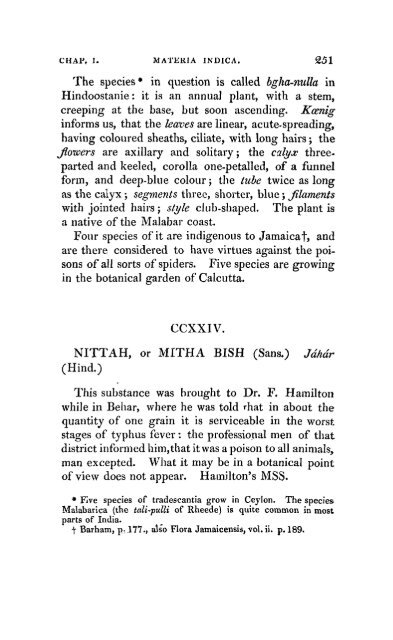You also want an ePaper? Increase the reach of your titles
YUMPU automatically turns print PDFs into web optimized ePapers that Google loves.
CHAP. I. MATEIUA <strong>INDICA</strong>. 251<br />
The species· in question is called bgha-nulla in<br />
Hindoostanie: it is an annual plant, with a stem,<br />
creeping at the base, but soon ascending. Kamig<br />
informs us, that the lea'oes are linear, acute-spreading,<br />
having coloured sheaths, ciliate, with long hairs; the<br />
.flowers are axillary and solitary; the calyx three.<br />
parted and keeled, corolla one-petalled, of a funnel<br />
form, and deep-blue colour; the tube twice as long<br />
as the calyx; segments three, shorter, blue; filaments<br />
with jointed hairs; style club-shaped. The plant is<br />
a native of the Malabar coast.<br />
Four species of it are indigenous to Jamaica t, and<br />
are there considered to have virtues against the poisons<br />
of all sorts of spiders. Five species are growing<br />
in the botanical garden of Calcutta.<br />
CCXXIV.<br />
NITTAH, or MITHA BISH (Sans.) Jdhar<br />
(Hind.)<br />
This substance was hrought to Dr. F. Hamilton<br />
while in Behar, where he was told rhat in about the<br />
quantity of one grain it is serviceable in the worst<br />
stages of typhus fever: the professiopal men of that<br />
district informed him, that it was a poison to all animals,<br />
man excepted. What it may be in a botanical point<br />
of view does not appear. Hamjlton's 1\1SS.<br />
;\I Five species of tradescantia grow in Ceylon. The species<br />
Malabarica (the tali-plllli of Rheede) is quite common in most<br />
parts of India.<br />
t Barham, p, J 77" a1so Flora Jamaicensis, vol. ii. p.189.

















